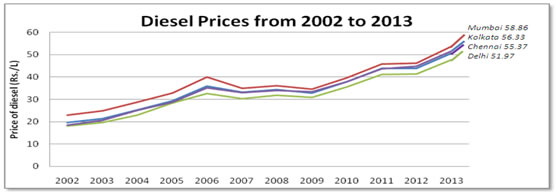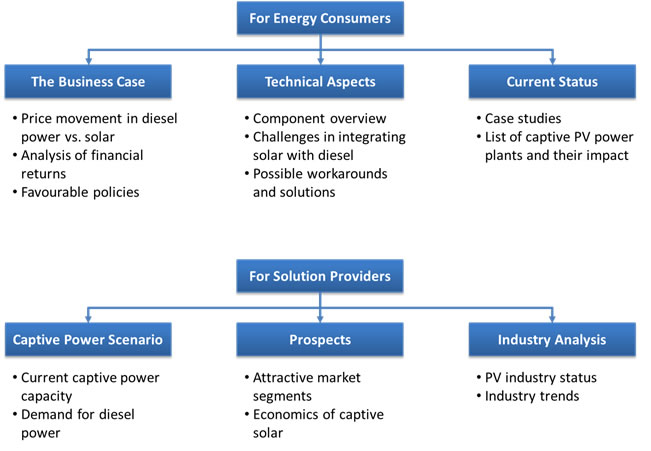The Replacing
Diesel with Solar report is the outcome of EAI’s extensive
interaction with clients who are looking for a solar solution to abate diesel
consumption. The need for a diesel abating solution is obvious: not only does
diesel power cause a lot of pollution, but it is also very expensive
- Power from diesel costs anywhere between Rs. 16-40/kWh, depending on the application
- The price of diesel has increased 300% since 2002 and 46% since 2010

Captive solar power costs just Rs. 7-8.5/kWh, and once the plant is installed
the cost of power is fixed for the next 25 years unlike diesel where the cost
keeps increasing! Despite the obvious advantages of
using captive solar power there is a lot of uncertainty, both amongst energy
consumers and solar solution providers, on how to implement a solar solution
that provides the maximum value at the minimum of cost. The Replacing Diesel with Solar report is designed
to provide a clear and objective assessment of captive solar as a diesel
abating solution.

Frequent unavailability of power
from the grid is a critical problem faced by Indian industries, and with the
Indian industry growing at a hectic pace, this deficit is even more harmful. According to a recent study carried
out by the Manufacturers' Association for Information Technology (MAIT) and
US-based power distribution solutions provider Emerson Network Power, India Inc
lost Rs 43,205 crores (about $10 billion) in 2008-09 due to power outages. The
revenue loss due to power failure grew at an aveerage of 11.9% in the past five
years.
Other industries facing a similar
problem include textiles, cement, paper, sugar mills, ceramic industries etc.
These industries are energy intensive in nature and thus power costs form the
most critical cost component.
Many large companies have resorted
to having their own captive power plants. At present, there are about 2,759
industrial units using captive generation power plants (both renewable and
non-renewable) with a capacity of 1 MW and above. Many smaller businesses and
commercial institutions rely to a large extent on diesel for backup power. To
the latter and to some extent to the former, solar PV based power production
could be an attractive option. This report will help you set up a captive solar
PV power plant for your business or company.
The Replacing Diesel with Solar report
is a comprehensive guide to setting up solar based captive power plants for
industries and commercial buildings. Apart from providing details on setting up
captive power, the report also provides inputs on how solar based captive power
can be segmented according to the needs: back up type; solar captives for
quality power; solar captives for multiple benefits and captives for reducing
costs of production of electricity.
The Replacing Diesel with Solar
Report was prepared by EAI (www.eai.in) as a response to the need in the
market for a detailed report that provides a detailed picture on solar based
captive power generation.
For industries and companies both
large and small keen on setting up captive power for their power consumption,
the report will provide insights on the following:
- Steps involved in setting up an offgrid solar PV power plant
- Key pre-requirements for setting up a captive solar power for your premises
- Capital and operating costs
- Returns - especially when compared to diesel - IRR, RoI, payback period, scenario analysis
- Financing options
- Land requirements
- The complete value chain for setting up a solar PV for off grid, captive consumption
- Companies and entities involved in the setting up of a captive solar power plant
- Case studies of existing off grid, captive solar installations in India and key takeaways
- While solar PV based captive power generation is in its infancy, there are specific market segments which have clean pain points that could be addressed well by solar PV. As a result, these segments are likely to have a much higher adoption of solar PV for captive power generation
- Solar PV is most cost competitive as a replacement for diesel-based power production. India has about 7,000 MW of diesel based power production in MW scales alone, with hundreds of thousands of diesel gen sets used in diverse commercial locations from over 2,50,000 mobile telecom towers to over 5 million diesel based agricultural pump sets, and with tens of thousands of companies and industries using it for power generation from small kW to hundreds of kw’s
- Grid-tied solar PV systems are the most common systems used in captive power production in India. The use of diesel solar hybrids is growing; however, the growth in use of wind-solar hybrid systems has much slower than expected, owing primarily to performance issues with micro wind turbines
- It costs about Rs. 80,000-1,00,000 per kW for setting up a captive solar PV system without battery storage and about 30-50% more for a system with batteries depending on the hours of autonomy There are a number of established companies that can take up turnkey implementation of captive solar PV systems; in addition, there are dozens of small players operating in this market, with this number expected to increase dramatically in the near future
- The National Solar Mission has a special section of incentives for off grid solar power production, with incentives in the form of capital subsidies. In addition, captive solar power plants can also avail accelerated depreciation benefits
- Set as a replacement for diesel power generation, captive solar PV power plants provide attractive equity IRRs and equity payback periods, under typical financing patterns
- Until now, the most preferred route for captive solar PV has been the corporate financing route. However, with the expected large scale adoption of captive solar PV power plants, it can be expected that both project finance and asset finance routes to come into vogue as well
- There are over a hundred installations of small scale solar PV based captive power generation, adding to about 2.4 MW of total capacity. Learning’s from the existing power plants are only emerging and one can expect significant insights from these as their numbers increase within the next few years
- Why should I go for solar based captive power?
- What are the key advantages of using solar PV as a replacement for diesel?
- How much solar PV capacity do I need for my electricity requirements?
- How much will it cost to install a solar PV captive system?
- What are the operational and maintenance costs for a solar PV power system for my premises?
- What are the key things I should look out for before installing a solar PV system?
- What are the mistakes I should avoid?
- How much space will I need for the captive PV installation?
- Should I use solar as a backup power or as a mainstream power source?
- Will I be able to depend completely on solar energy for my day time operations?
- If I operate night shifts, will I need a storage system (battery) for my energy needs?
- Can I sell my excess energy to the grid?
- What are the components of the solar PV system?
- What is the lifetime of the system and its components?
- Am I eligible for availing government incentives?
- Can I install a hybrid captive system (mix of solar and wind OR solar and diesel)?
- When should I consider using a diesel generator along with my solar PV system?
- What are the disadvantages and bottlenecks in using solar PV for off grid power?
- Companies with unreliable grid supply having significant dependence on diesel for backup power, and are keen on setting up a reliable power system with attractive long term cost benefits
- Industries and commercial buildings that have enough roof top or ground space
- Companies and businesses that are keen to show their green credentials while at the same time solving a critical problem of backup power source
Compiled by a diverse team of
experts, with experience in industrial fields, the Replacing Diesel with
Solar is the first report that provides in-depth analysis and insights on
this important field. It uses innumerable data and information from a wide
variety of expert sources and market studies, and distills these inputs and
data into intelligence and a road map that you can use.
Continue reading at .....
Good information for cost saving initiative.
ReplyDelete